-
 Bitcoin
Bitcoin $84,511.1544
1.57% -
 Ethereum
Ethereum $1,616.8895
2.64% -
 Tether USDt
Tether USDt $0.9996
-0.02% -
 XRP
XRP $2.1289
1.52% -
 BNB
BNB $585.3538
0.63% -
 Solana
Solana $128.8772
2.24% -
 USDC
USDC $0.9997
-0.03% -
 TRON
TRON $0.2518
-0.28% -
 Dogecoin
Dogecoin $0.1577
-2.53% -
 Cardano
Cardano $0.6325
-0.29% -
 UNUS SED LEO
UNUS SED LEO $9.4025
1.17% -
 Avalanche
Avalanche $20.0866
3.58% -
 Chainlink
Chainlink $12.6336
1.05% -
 Stellar
Stellar $0.2380
0.75% -
 Toncoin
Toncoin $2.8660
0.26% -
 Sui
Sui $2.1775
-1.65% -
 Shiba Inu
Shiba Inu $0.0...01194
-0.44% -
 Hedera
Hedera $0.1646
0.09% -
 Bitcoin Cash
Bitcoin Cash $324.1697
-4.94% -
 Litecoin
Litecoin $76.7294
-0.36% -
 Polkadot
Polkadot $3.6844
0.76% -
 Dai
Dai $0.9999
-0.01% -
 Hyperliquid
Hyperliquid $15.6633
3.87% -
 Bitget Token
Bitget Token $4.2787
0.04% -
 Pi
Pi $0.7363
2.23% -
 Ethena USDe
Ethena USDe $0.9989
-0.01% -
 Monero
Monero $214.6360
5.94% -
 Uniswap
Uniswap $5.3573
1.26% -
 OKB
OKB $52.8476
-0.10% -
 Pepe
Pepe $0.0...07260
0.99%
Why might a Bitcoin ETF have a premium or discount?
Bitcoin ETFs may trade at premiums or discounts due to market demand, supply dynamics, liquidity, and regulatory factors, impacting investor returns.
Apr 11, 2025 at 10:15 am
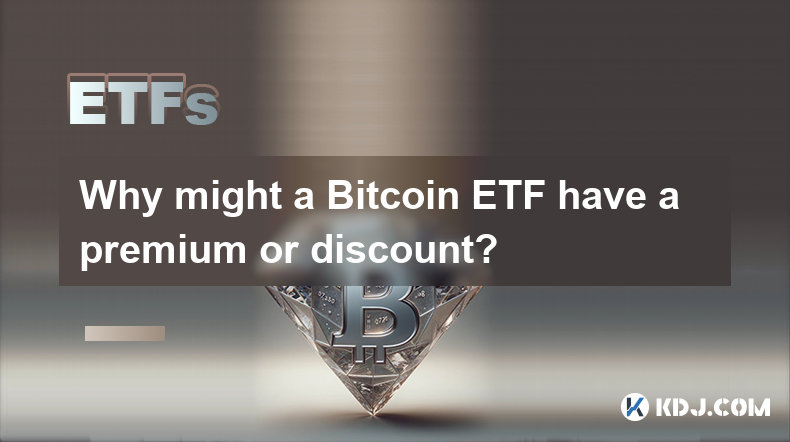
A Bitcoin Exchange Traded Fund (ETF) is a financial product that tracks the price of Bitcoin and allows investors to gain exposure to the cryptocurrency without directly owning it. One of the key aspects that investors need to understand about Bitcoin ETFs is the concept of premiums and discounts. A premium occurs when the ETF's market price is higher than its net asset value (NAV), while a discount happens when the market price is lower than the NAV. Understanding why a Bitcoin ETF might trade at a premium or discount is crucial for investors looking to make informed decisions.
Market Demand and Supply Dynamics
The primary reason a Bitcoin ETF might trade at a premium or discount is due to the dynamics of market demand and supply. When there is high demand for the ETF and limited supply, the market price can rise above the NAV, resulting in a premium. Conversely, if there is low demand and an excess supply of the ETF, the market price can fall below the NAV, leading to a discount. These dynamics are influenced by various factors, including investor sentiment, market trends, and the overall performance of Bitcoin.
Arbitrage Opportunities
Arbitrageurs play a significant role in the pricing of Bitcoin ETFs. Arbitrage involves buying the ETF when it trades at a discount and selling it when it trades at a premium, thereby profiting from the price difference. This activity helps to keep the ETF's market price closely aligned with its NAV. However, if arbitrageurs are unable to quickly capitalize on these opportunities due to market inefficiencies or other constraints, the ETF can continue to trade at a premium or discount for extended periods.
Liquidity and Trading Volume
The liquidity and trading volume of a Bitcoin ETF can also impact whether it trades at a premium or discount. ETFs with higher liquidity and trading volumes tend to have smaller premiums and discounts because there are more buyers and sellers in the market, facilitating easier price adjustments. On the other hand, ETFs with lower liquidity and trading volumes may experience larger premiums and discounts due to the difficulty in executing trades at desired prices.
Regulatory and Operational Factors
Regulatory and operational factors can also contribute to premiums and discounts in Bitcoin ETFs. Regulatory changes or uncertainties can affect investor confidence and lead to fluctuations in demand and supply, causing the ETF to trade at a premium or discount. Additionally, operational issues such as delays in the creation and redemption process of ETF shares can impact the ETF's ability to track the NAV closely, leading to pricing discrepancies.
Market Sentiment and Speculation
Market sentiment and speculation are other factors that can influence whether a Bitcoin ETF trades at a premium or discount. During periods of high optimism or fear in the cryptocurrency market, investors may be willing to pay a premium for the ETF, expecting future price increases. Conversely, during times of pessimism or uncertainty, investors may sell the ETF at a discount, anticipating future price declines. These sentiment-driven movements can cause significant deviations from the ETF's NAV.
Tracking Error
Tracking error refers to the difference between the performance of the ETF and the performance of the underlying asset, in this case, Bitcoin. A higher tracking error can lead to larger premiums and discounts because the ETF's market price may not accurately reflect the value of the underlying Bitcoin holdings. Factors contributing to tracking error include management fees, transaction costs, and the timing of rebalancing the ETF's portfolio.
Impact of Fees and Expenses
Fees and expenses associated with the Bitcoin ETF can also affect its market price relative to its NAV. Higher fees can erode the ETF's returns, leading to a larger discount as investors demand a lower price to compensate for the reduced net value. Conversely, lower fees can attract more investors, potentially leading to a premium if the demand outpaces the supply of ETF shares.
Market Maker Activity
Market makers are entities that provide liquidity to the ETF market by buying and selling ETF shares. Their activity can influence whether the ETF trades at a premium or discount. If market makers are actively managing the ETF's price to keep it close to the NAV, premiums and discounts may be minimized. However, if market makers are less active or face constraints, the ETF may experience larger pricing discrepancies.
Conclusion
Understanding the factors that contribute to premiums and discounts in Bitcoin ETFs is essential for investors. Market demand and supply dynamics, arbitrage opportunities, liquidity and trading volume, regulatory and operational factors, market sentiment and speculation, tracking error, fees and expenses, and market maker activity all play a role in determining whether a Bitcoin ETF trades at a premium or discount. By considering these factors, investors can make more informed decisions and better manage their exposure to Bitcoin through ETFs.
Frequently Asked Questions
Q: Can premiums and discounts in Bitcoin ETFs be predicted?
A: While it is challenging to predict premiums and discounts with certainty, understanding the factors that influence them can help investors anticipate potential movements. Monitoring market sentiment, liquidity, and regulatory changes can provide insights into possible future premiums and discounts.
Q: How can investors mitigate the impact of premiums and discounts on their investments?
A: Investors can mitigate the impact of premiums and discounts by diversifying their portfolios, regularly monitoring the ETF's market price relative to its NAV, and taking advantage of arbitrage opportunities when possible. Additionally, choosing ETFs with lower fees and higher liquidity can help minimize the effects of pricing discrepancies.
Q: Are premiums and discounts more common in Bitcoin ETFs than in traditional ETFs?
A: Premiums and discounts can occur in any type of ETF, but they may be more pronounced in Bitcoin ETFs due to the higher volatility and speculative nature of the cryptocurrency market. The unique characteristics of Bitcoin, such as its limited supply and decentralized nature, can also contribute to larger pricing discrepancies in Bitcoin ETFs compared to traditional ETFs.
Q: How do premiums and discounts affect the overall performance of a Bitcoin ETF?
A: Premiums and discounts can significantly impact the overall performance of a Bitcoin ETF. If an investor buys the ETF at a premium and the premium decreases over time, the investor may experience a loss even if the underlying Bitcoin price remains stable. Conversely, buying the ETF at a discount and seeing the discount narrow can enhance returns. Therefore, understanding and managing premiums and discounts is crucial for maximizing the performance of a Bitcoin ETF investment.
Disclaimer:info@kdj.com
The information provided is not trading advice. kdj.com does not assume any responsibility for any investments made based on the information provided in this article. Cryptocurrencies are highly volatile and it is highly recommended that you invest with caution after thorough research!
If you believe that the content used on this website infringes your copyright, please contact us immediately (info@kdj.com) and we will delete it promptly.
- Vaulta Emerges from Its Past with a Renewed Focus on Practical Finance and Compliance-First Blockchain Infrastructure
- 2025-04-15 04:50:13
- Render Network (RNDR), SEI and Bittensor (TAO) lead crypto AI sector despite 5% daily drop
- 2025-04-15 04:50:13
- HYPE is showing early signs of a bullish reversal, with a potential inverse head and shoulders pattern forming
- 2025-04-15 04:45:13
- BlockDAG (BDAG) Captures Developer Attention with Complete Smart Contract Features and Growing $214M Presale
- 2025-04-15 04:45:13
- title: RWA-Focused Crypto Project MANTRA (OM) Loses $5.431B of Market Cap in Overnight Collapse of Its Native Token
- 2025-04-15 04:40:15
- Trump's Tariffs Just Supercharged Bitcoin – Here's What's Coming
- 2025-04-15 04:40:15
Related knowledge
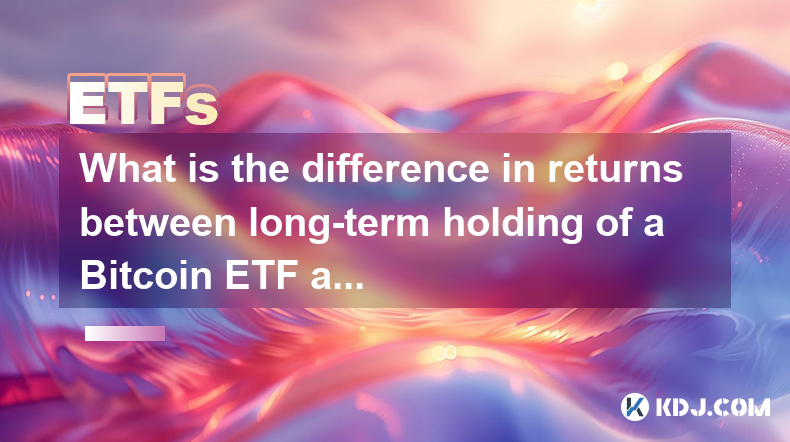
What is the difference in returns between long-term holding of a Bitcoin ETF and holding Bitcoin directly?
Apr 09,2025 at 04:15am
When considering the difference in returns between long-term holding of a Bitcoin ETF and holding Bitcoin directly, it's essential to understand the nuances and factors that affect each investment option. Both approaches have their unique advantages and potential drawbacks, which can significantly impact the overall returns over time. Understanding Bitc...
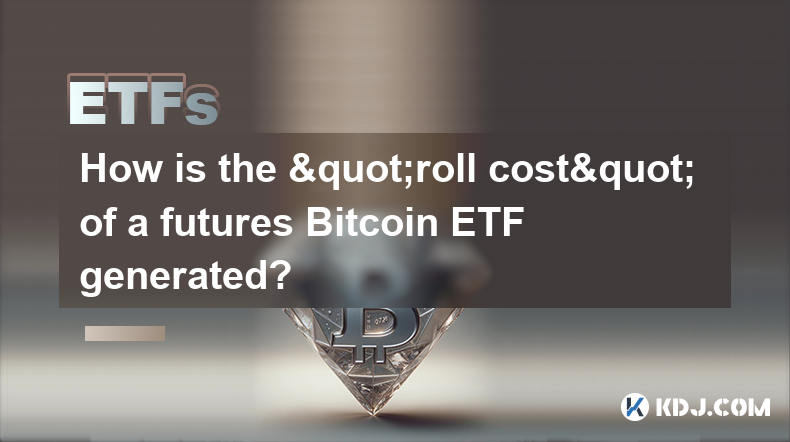
How is the "roll cost" of a futures Bitcoin ETF generated?
Apr 08,2025 at 01:22pm
The 'roll cost' of a futures Bitcoin ETF is a critical concept for investors to understand, as it directly impacts the performance of the ETF. In this article, we will delve into the mechanics of how the roll cost is generated, exploring the underlying processes and factors that contribute to this cost. Understanding Futures ContractsFutures contracts a...
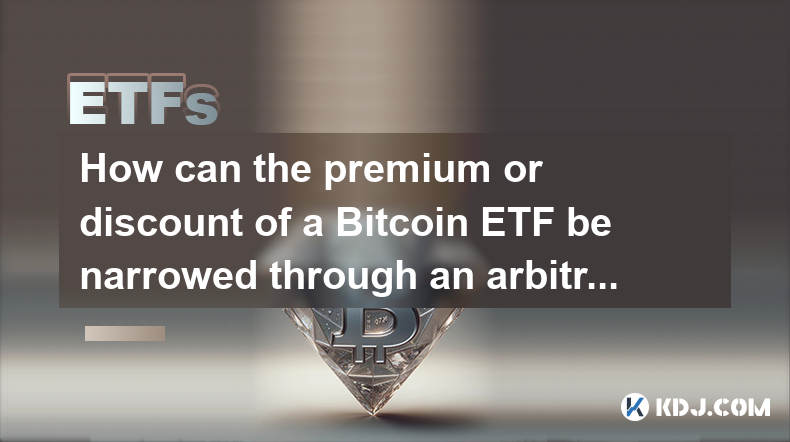
How can the premium or discount of a Bitcoin ETF be narrowed through an arbitrage mechanism?
Apr 09,2025 at 12:07am
Arbitrage mechanisms play a crucial role in narrowing the premium or discount of a Bitcoin Exchange Traded Fund (ETF). Understanding how these mechanisms work can provide valuable insights into the dynamics of Bitcoin ETFs and their relationship with the underlying asset. This article will delve into the specifics of how arbitrage can be used to align t...

What factors affect the bid-ask spread of a Bitcoin ETF?
Apr 08,2025 at 08:50pm
The bid-ask spread of a Bitcoin Exchange Traded Fund (ETF) is a critical metric that investors and traders closely monitor. It represents the difference between the highest price a buyer is willing to pay (bid) and the lowest price a seller is willing to accept (ask). Several factors influence this spread, and understanding them can help investors make ...
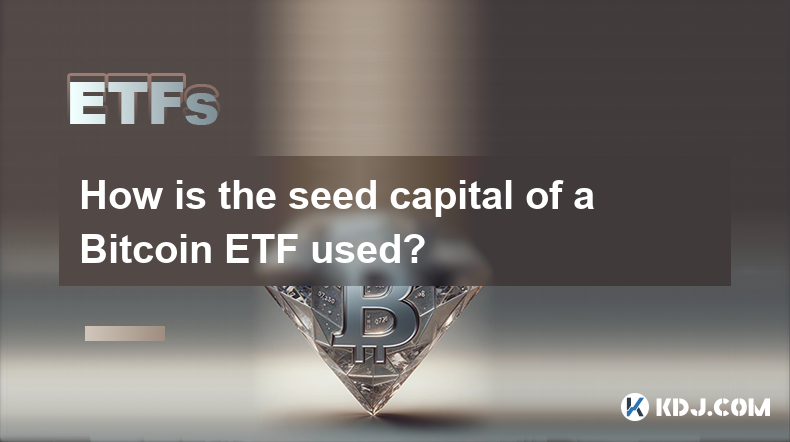
How is the seed capital of a Bitcoin ETF used?
Apr 10,2025 at 02:15pm
The seed capital of a Bitcoin ETF plays a crucial role in the establishment and operation of the fund. This initial investment is used to create the fund's underlying assets, manage operational costs, and ensure the ETF can start trading on an exchange. Understanding how this seed capital is utilized provides insight into the mechanics of Bitcoin ETFs a...
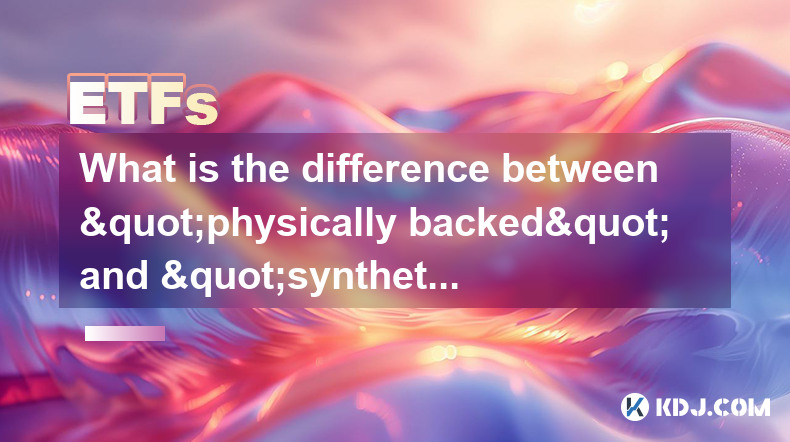
What is the difference between "physically backed" and "synthetic" Bitcoin ETFs in terms of holding assets?
Apr 10,2025 at 04:56pm
Bitcoin Exchange Traded Funds (ETFs) have become a popular way for investors to gain exposure to the cryptocurrency market without directly owning the underlying asset. There are two primary types of Bitcoin ETFs: physically backed and synthetic. Understanding the differences between these two types, particularly in terms of how they hold assets, is cru...

What is the difference in returns between long-term holding of a Bitcoin ETF and holding Bitcoin directly?
Apr 09,2025 at 04:15am
When considering the difference in returns between long-term holding of a Bitcoin ETF and holding Bitcoin directly, it's essential to understand the nuances and factors that affect each investment option. Both approaches have their unique advantages and potential drawbacks, which can significantly impact the overall returns over time. Understanding Bitc...

How is the "roll cost" of a futures Bitcoin ETF generated?
Apr 08,2025 at 01:22pm
The 'roll cost' of a futures Bitcoin ETF is a critical concept for investors to understand, as it directly impacts the performance of the ETF. In this article, we will delve into the mechanics of how the roll cost is generated, exploring the underlying processes and factors that contribute to this cost. Understanding Futures ContractsFutures contracts a...

How can the premium or discount of a Bitcoin ETF be narrowed through an arbitrage mechanism?
Apr 09,2025 at 12:07am
Arbitrage mechanisms play a crucial role in narrowing the premium or discount of a Bitcoin Exchange Traded Fund (ETF). Understanding how these mechanisms work can provide valuable insights into the dynamics of Bitcoin ETFs and their relationship with the underlying asset. This article will delve into the specifics of how arbitrage can be used to align t...

What factors affect the bid-ask spread of a Bitcoin ETF?
Apr 08,2025 at 08:50pm
The bid-ask spread of a Bitcoin Exchange Traded Fund (ETF) is a critical metric that investors and traders closely monitor. It represents the difference between the highest price a buyer is willing to pay (bid) and the lowest price a seller is willing to accept (ask). Several factors influence this spread, and understanding them can help investors make ...

How is the seed capital of a Bitcoin ETF used?
Apr 10,2025 at 02:15pm
The seed capital of a Bitcoin ETF plays a crucial role in the establishment and operation of the fund. This initial investment is used to create the fund's underlying assets, manage operational costs, and ensure the ETF can start trading on an exchange. Understanding how this seed capital is utilized provides insight into the mechanics of Bitcoin ETFs a...

What is the difference between "physically backed" and "synthetic" Bitcoin ETFs in terms of holding assets?
Apr 10,2025 at 04:56pm
Bitcoin Exchange Traded Funds (ETFs) have become a popular way for investors to gain exposure to the cryptocurrency market without directly owning the underlying asset. There are two primary types of Bitcoin ETFs: physically backed and synthetic. Understanding the differences between these two types, particularly in terms of how they hold assets, is cru...
See all articles























































































